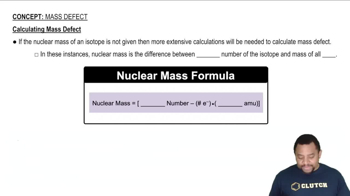The thermite reaction, Fe2O31s2 + 2 Al1s2 ¡2 Fe1s2 + Al2O31s2, H = -851.5 kJ>mol, is one of the most exothermic reactions known. Because the heat released is sufficient to melt the iron product, the reaction is used to weld metal under the ocean. How much heat is released per mole of Al2O3 produced? How does this amount of thermal energy compare with the energy released when 2 mol of protons and 2 mol of neutrons combine to form 1 mol of alpha particles?
Ch.21 - Nuclear Chemistry

Brown15th EditionChemistry: The Central ScienceISBN: 9780137542970Not the one you use?Change textbook
Chapter 21, Problem 48
How much energy must be supplied to break a single ²¹Ne nucleus into separated protons and neutrons if the nucleus has a mass of 20.98846 amu? What is the nuclear binding energy for 1 mol of ²¹Ne?
 Verified step by step guidance
Verified step by step guidance1
Step 1: Determine the number of protons and neutrons in the ²¹Ne nucleus. Neon (Ne) has an atomic number of 10, which means it has 10 protons. Since the mass number is 21, the number of neutrons is 21 - 10 = 11.
Step 2: Calculate the total mass of the separated protons and neutrons. Use the mass of a proton (approximately 1.00728 amu) and the mass of a neutron (approximately 1.00866 amu) to find the total mass of 10 protons and 11 neutrons.
Step 3: Find the mass defect by subtracting the actual mass of the ²¹Ne nucleus (20.98846 amu) from the total mass of the separated protons and neutrons calculated in Step 2.
Step 4: Convert the mass defect into energy using Einstein's equation, E = mc², where m is the mass defect in kilograms and c is the speed of light (approximately 3.00 x 10^8 m/s). Remember to convert amu to kg (1 amu = 1.660539 x 10^-27 kg).
Step 5: Calculate the nuclear binding energy for 1 mol of ²¹Ne by multiplying the energy per nucleus by Avogadro's number (approximately 6.022 x 10^23 mol^-1).
Key Concepts
Here are the essential concepts you must grasp in order to answer the question correctly.
Nuclear Binding Energy
Nuclear binding energy is the energy required to disassemble a nucleus into its constituent protons and neutrons. It is a measure of the stability of a nucleus; the higher the binding energy, the more stable the nucleus. This energy can be calculated using the mass defect, which is the difference between the mass of the individual nucleons and the mass of the nucleus itself, converted into energy using Einstein's equation, E=mc².
Recommended video:
Guided course

Nuclear Binding Energy
Mass Defect
The mass defect refers to the difference in mass between a nucleus and the sum of the masses of its individual protons and neutrons. This discrepancy arises because some mass is converted into energy when nucleons bind together, resulting in a lower mass for the nucleus. Understanding the mass defect is crucial for calculating the binding energy, as it directly influences the amount of energy needed to break the nucleus apart.
Recommended video:
Guided course

Calculating Mass Defect
Molar Binding Energy
Molar binding energy is the binding energy per mole of nuclei, providing a macroscopic measure of nuclear stability. It is calculated by multiplying the binding energy of a single nucleus by Avogadro's number (approximately 6.022 x 10²³). This concept is essential for understanding the energy involved in nuclear reactions on a larger scale, such as in nuclear power or astrophysical processes.
Recommended video:
Guided course

Nuclear Binding Energy
Related Practice
Textbook Question
Textbook Question
How much energy must be supplied to break a single aluminum-27 nucleus into separated protons and neutrons if an aluminum-27 atom has a mass of 26.9815386 amu? How much energy is required for 100.0 g of aluminum-27? (The mass of an electron is given on the inside back cover.)
Textbook Question
The atomic masses of hydrogen-2 (deuterium), helium-4, and lithium-6 are 2.014102 amu, 4.002602 amu, and 6.0151228 amu, respectively. For each isotope, calculate
(c) the nuclear binding energy per nucleon.
Textbook Question
The atomic masses of nitrogen-14, titanium-48, and xenon-129 are 13.999234 amu, 47.935878 amu, and 128.904779 amu, respectively. For each isotope, calculate (a) the nuclear mass.
